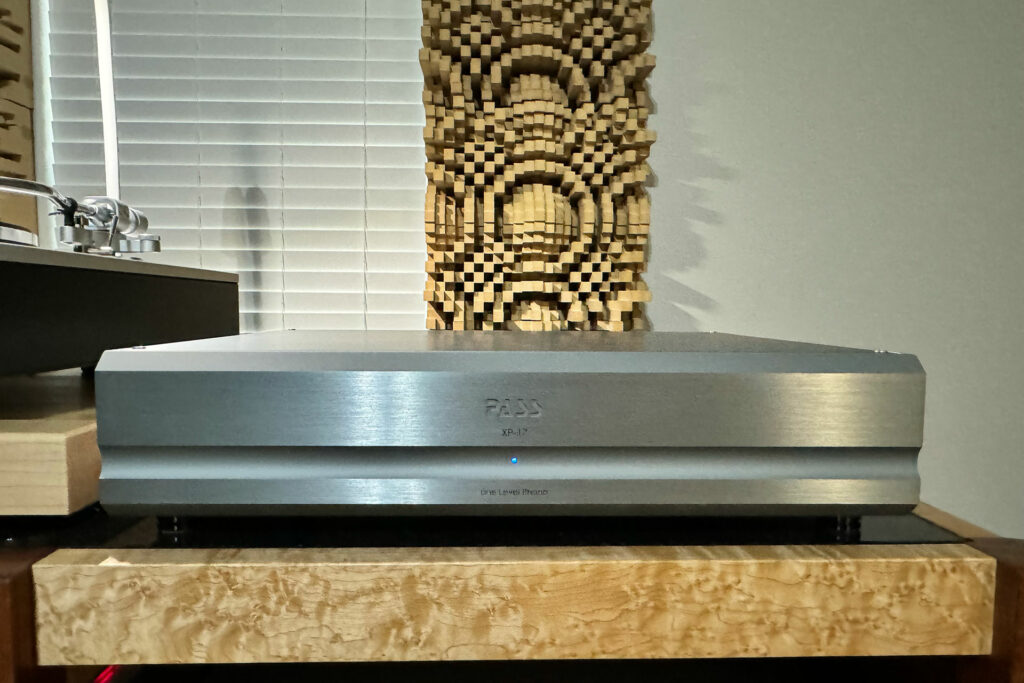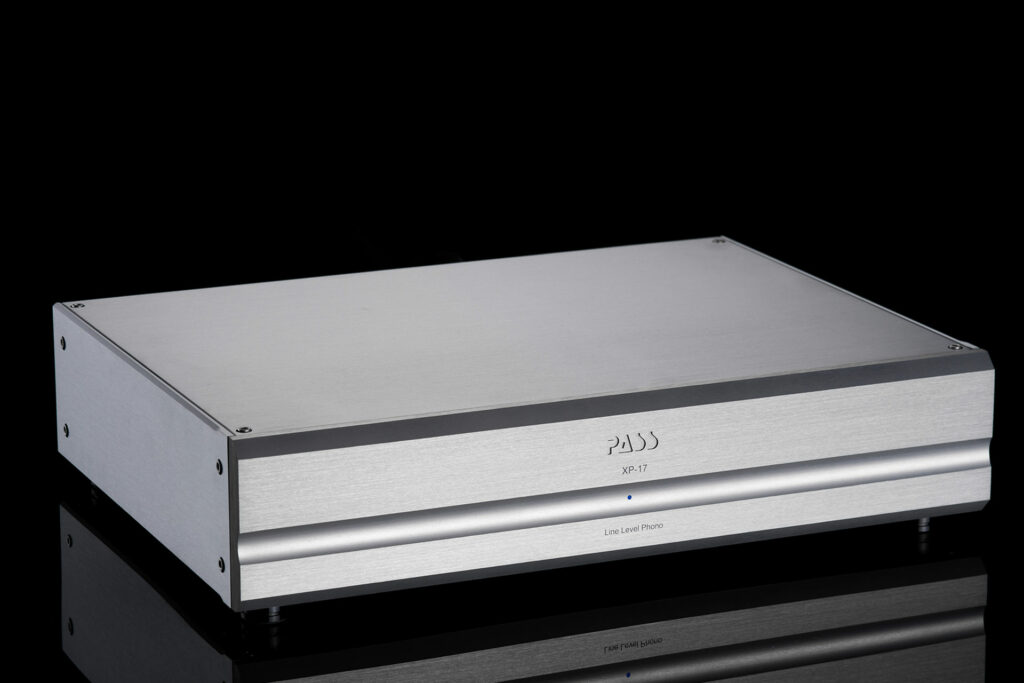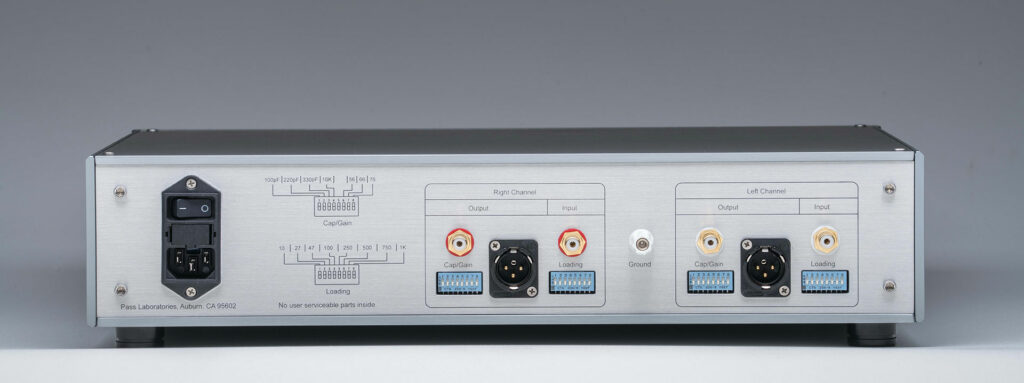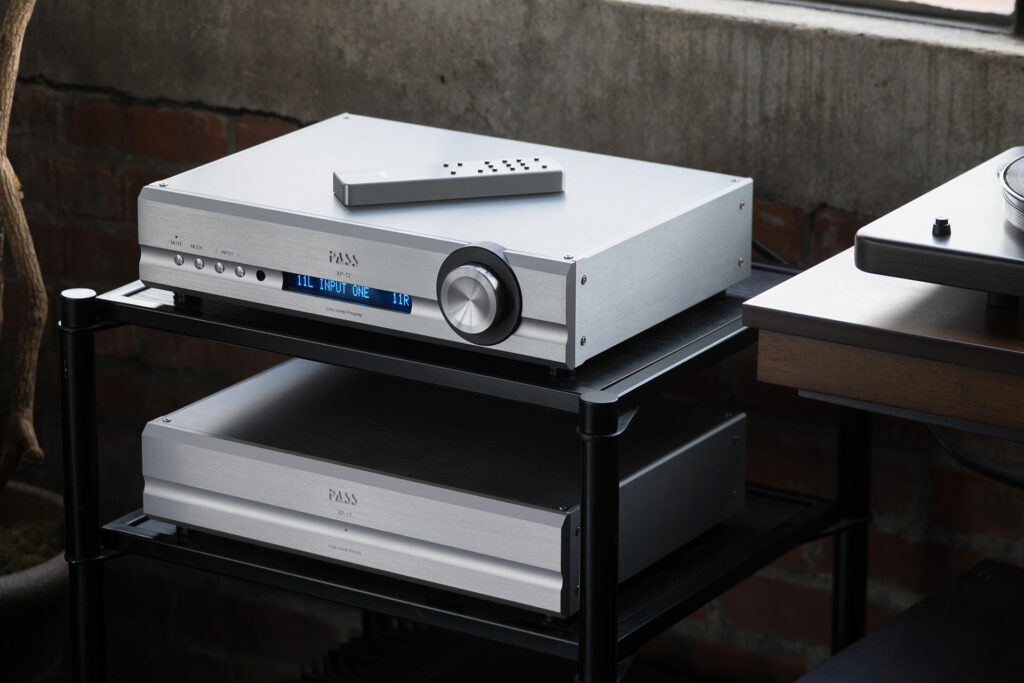When commercial operations first began in 1991, Pass Labs took the innovative amplifier creations from the kitchen table of founder Nelson Pass and rose to become one of the more respected and awarded audio companies currently in business. In 1994, Nelson Pass added engineer/designer Wayne Colburn and, to this day, Colburn designs most Pass Labs preamps and phonostages. However, product design is predominantly a collaboration between both prior to final release. Since Pass Labs’ founding, the company has stayed pretty much true to their beginning, and today produces highly sought-after and awarded audiophile power amps, preamps and phonostages. In this review, we will be examining their entry-level phonostage, the Pass Labs XP-17.

What Makes the Pass Labs XP-17 Phonostage So Special?
- Through the innovative use of shielded, low-noise filter modules, unwanted mechanical and even radiated noise are kept to a minimum. In fact, lowering the noise floor is one of the main design goals of the Pass Labs XP-17.
- The Pass Labs XP-17 is capable of accepting Moving Magnet (MM), Moving Coil (MC) and Moving Iron (MI) cartridges. Conveniently, and unlike most phonostages, there is no need to switch between any of the three types of cartridge technologies. The unit is usefully designed to accommodate any type of cartridge, with no user differentiation. This makes it impossible to forget to switch to a different setting after changing cartridge designs.
- The Pass Labs XP-17 is a stereo design internally thus delivers true balanced performance to run through your XLR cables. There are likewise left and right cable connections and user-changeable gain and load settings. If you want a dual mono power supply, that is the next model up, the Pass Labs XP-27, which I have in for review now so stay tuned for thoughts on that unit.
- Gain settings of 56dB, 66dB and 76dB are user-adjustable. The highest gain setting, 76dB, is very helpful in providing increased amplitude when using low-output MC cartridges.
- Resistive loading is user-selectable from 10 ohms to 47k ohms. For MM cartridges, 47k ohms is the nearly universal resistive setting. The remainder are used to dial in the resistive settings of MC cartridges.
- Something very few phonostages at this price point include are three user-defined settings for capacitive loading. Values for this are 100 picofarads (represented as pF), 220pF and 320pF. For reference, a picofarad is a unit of capacitance and, numerically, represents one-trillionth of a farad.
A note about Pass Labs’ somewhat unique approach to cartridge set-up: While gain is mostly straightforward (that is, higher output cartridges require less gain than low output versions), cartridge loading is not so much an exact science. Pass Labs recommends, as does pretty much the entire industry, that MM cartridges employ a standardized load of 47k ohms. MC cartridges, however, may (or may not) greatly benefit from variable load settings. For this reason, the other resistive load options are available. Pass Labs ingeniously takes it one step further by also including three parallel capacitive load settings, designed to work in concert with the standard resistive load settings in ohms. While MC cartridges are less susceptible to changes in capacitive loading than, say, MM cartridges, it does not mean some MC cartridges will not benefit in some way with these options. It is up to the user to decide if capacitive loading partnered with resistive loading renders any useful benefit. Because there are so many different designs of MC and MM cartridges, finding the ideal balance between resistive and capacitive loads, and the resultant sonics, are best accomplished by the time-honored practice of listening to hear what sounds best. In fact, this is exactly what Pass Labs recommends.
- Because of its dual mono design, there are output connections for XLR and RCA to make connecting to a preamp quite simple.
- Set-up is appropriately straightforward. I first connected the audiophile turntable tonearm cable and ground, then the output connections to my preamp and, finally, the power cord. Lastly, I flipped the rear-mounted power switch to the on position.
- The Pass Labs XP-17 is designed to be continuously powered on. There is no need to turn the unit off, unless the system will be unattended for an extended period of time. It is always a good idea to power down and unplug an entire system during a violent thunderstorm. However, leaving the XP-17 on all the time, under normal conditions, will typically present no problems at all.
- The machined aluminum case is very robust and heavy-walled. There is an overall feeling of weight, heft and superlative build quality. Every audiophile has a healthy appreciation for such wonderful build quality.
- The Pass Labs XP-17 is designed to be a very simple, user-friendly device. As such, once the settings have been optimized, it is generally assumed that there will not be much need for further settings changes – unless, of course, a new and differently-designed cartridge will be used. Basically, the Pass Labs XP-17 is a one-turntable, one-tonearm, one-cartridge-at-a-time phonostage.

Why Should You Care About the Pass Labs XP-17 Phonostage?
There are a wide variety of phonostages in this price category – some slightly less expensive, some slightly more. Most have similar features, but not always. When choosing a phonostage to use in a system’s analog section, finding one with the best balance of features, build quality, performance and price is completely obvious. What is generally unknown is how any device will make playing an LP really sound. Given the attention to noise reduction, overall build quality and wide variety of cartridge settings compared to the retail price, the Pass Labs XP-17 is a very smart choice for anyone interested in a highly capable phonostage in this price point.

Some Things You Might Not Like About the Pass Labs XP-17…
- There is no display screen. Pass Labs elected to not use an active display because of noise issues, cost and, predominantly, because of their belief that once the settings are optimized, very few changes will be enacted, so a display is simply not needed. All one sees on the front is a small center-mounted blue pilot light.
- There is no remote control. I will admit, in my early use of this phonostage, having to keep getting up and running to the audio rack for yet another minor adjustment proved irritating. A remote would have made things easier during set-up, but once the settings were dialed in, I pretty much forgot about all the jumping up and down I had to do and just sat back and enjoyed music. At that point, having a remote offered no additional benefit. And because I never powered the XP-17 off anyway, needing a remote to do so was unnecessary.
- The gain and load settings are all on the back of the unit and not front-mounted. Additionally, all gain and load selections are made by changing a series of small DIP switches on the back of the unit. In order to alter the user settings, I used a flashlight and a very small, thin, flat-blade screwdriver to flip individual DIP switches up and down. While I will admit front-mounted knobs would have made changing the various settings much easier, after a variety of adjustments over the course of about two weeks, I “found my sound” and could thankfully pay attention to the music and not the settings.
Listening With the Pass Labs XP-17 Phonostage…
Upon lowering the tonearm on my first LP after making all the connections, my first thought was “wow.” My second thought was I was hearing more of an explosion of music which, admittedly, I did not expect. What I heard that first day was a harmony of dynamics, clean and clear bass lines, so much so that following the notes were easily accomplished, exceptional imaging, clarity and, overall, a highly pleasing sound. I actually leaned back in my recliner, something I almost never do for a review, and just basked in the music. Over the next couple of weeks, as I experimented with the various settings, and the unit broke in somewhat, I was rewarded with yet another improved level of sonics.
About the same time that I received the Pass Labs XP-17, my copy of the MoFi UltraDisc One-Step LP of Bruce Springsteen’s Greetings From Asbury Park N.J. also arrived. I immediately cued up one of my favorite tracks from this recording, “Lost in the Flood.” This track plays through the first two minutes with only a piano and Springsteen’s vocals. At the two-minute mark, a rather concussive drum and loud cymbal crash kick in with substantial force and dynamic fortitude. It was at this point that I really began to take notice of the overall sound of one of Springsteen’s earlier recordings. This track exploited what I perhaps liked most about the Pass Labs XP-17 – its ability to present soft and delicate passages with finesse, yet positively explode when the recording demands. Adding to that an impressive image presentation and a natural sense of accuracy, clarity and timber triggered my second feeling of WOW.
Released in 1984, the third studio album from The Pretenders, Learning To Crawl was released after a hiatus after original band member James Honeyman-Scott died of a drug overdose. Track number two, “Back on The Chain Gang,” was written by lead singer Chrissie Hynde, who was three months pregnant at the time of recording. It was written, in part, as a tribute to Honeyman-Scott, and quickly rose to be a top ten hit on multiple US charts. I mention some of the historical background because this is a track of remembrances. Hynde’s voice has a certain angst-laden sound, portrayed well with the Pass Labs XP-17; her voice displayed the intended level of remorse. Something borrowed from an old Sam Cooke song, throughout the track at times can be heard the high-pitched sound of a hammer striking a railroad tie. Add in the dynamic “oh, ah’s,” and this track takes on a clear meaning. I was surprised to hear the hammer and “oh” and “ah” sounds presented so forcefully – more like a featured instrument rather than a transient sonic detail. In that, the Pass labs XP-17 performed admirably. The bass, midrange and treble were all equally portrayed, making this track neither bottom- nor top-heavy. Guitar and bass interplay with each other, as well as drums. All were easily recognizable, and the individual instruments easily followed. All in all, a great recording of a song written in a time of emotional sorrow.
Will the Pass Labs XP-17 Phonostage Hold Its Value?
Well, the simple answer is, absolutely, yes. Pass Labs equipment is very highly regarded, so finding an abundance of used product for sale is not always a simple task. When something does come up for sale, whether a local transaction, advertising through an audiophile website, or a commercial used resale company, Pass Labs products may be found for sale at very respectable prices and generally sell very quickly. Purchase of a used Pass Labs piece of equipment will normally be a win/win situation for both buyer and seller.

What Is the Competition for the Pass Labs XP-17 Phonostage?
Prior to the Pass Labs XP-17, I had the great pleasure to review the very impressive $5,995 Mobile Fidelity MasterPhono phonostage (read my review here). I would not characterize the nearly $1,500 increased difference in retail cost of the MasterPhono as indicative of overall quality and performance per se. Because, in actual practice, while I absolutely adored and was quite taken by the MoFi Masterphono. I also was also highly impressed by the XP-17. Both delivered a presentation of excellent clarity, excellent channel separation, black (meaning: quiet) background, superb imaging and nearly concussive dynamics. While each device employs a slightly different methodology to cartridge settings, and MoFi uses an admittedly ingenious approach to low-output MC cartridges, the Pass Labs XP-17 did not particularly suffer in any realistic performance metrics. Admittedly, the MoFi MasterPhono does have more features, a display screen and a remote, yet specifically in terms of sonics, in my estimation, both are more alike than dissimilar.
Having already reviewed the Boulder 1160 power amp (read my review here) and also the Boulder 1110 preamp (read my review here), I was curious to learn more about the $5,400 Boulder 508 phono preamp. Like all Boulder equipment, the 508 is a dual mono, fully-balanced design. Utilizing their in-house manufacturing, the circuit boards are through-hole technology, and Boulder performs all the machining. On purpose, this phonostage is a very simple design, done so to lower the noise floor and provide more simplistic circuitry. The power supply, which is normally a very noisy beast, is isolated in its own secure and galvanically separate compartment to help eliminate passed-through distortion. Oddly enough, there are only two gain settings, 70dB for MC and 44dB for MM. No other choices are offered. Impedance, once again, only has two choices – 100 ohms for MC and 47K for MM. And because Boulder absolutely does not believe in RCA connections, XLR are the only inputs and outputs found on the back of the device. This makes connecting existing RCA tonearm cables and certain outputs to a preamp more of a dedicated effort.
Another phonostage with impeccable credentials is the John Curl-designed Parasound JC3+. Some years ago, I owned one of these components, and found it to be incredibly neutral, providing a highly impressive sonic portrayal of my vinyl LPs. No doubt there have been improvements in the intervening years to up the sonic ante. Widely regarded as completely silent and possessing incredible dynamics, the Parasound JC3+ is a very popular unit among vinyl enthusiasts. Priced at $3,199, it is quite a bit less than the Pass Labs XP-17. However, gain is limited to 48dB on MM and 64dB on MC. If you have a low-output MC cartridge, as do I, this may be a problem. Impedance is fixed at 47K ohms for MM; for MC, there are dual rear-mounted potentiometers, one for each channel, with adjustment of 50 ohms to 550 ohms. Anyone with a more mainstream, higher-output MC cartridge will very likely find that the Parasound JC3+ will provide enough amplitude for reasonable listening and eliminate the need for a step-up transformer.

Final Thoughts on the Pass Labs XP-17 Phonostage…
For the most part, my initial connection of the XP-17 utilized almost all of the factory settings. One change I did make was to increase the gain to 76dB to better accommodate the 0.2mV output of my Ortofon MC Verismo cartridge. When I played the very first LP, music practically jumped from the speakers. What I heard was impressive, to say the least. Over the next two weeks, I played a wide variety of LPs. Some of them were MoFi UltraDisc One-Step, others very impressive-sounding LPs, still others were nice yet not remarkable, and several were irredeemable. As such, I could readily assess the Pass Labs XP-17’s strengths. With the availability of load and gain settings, I was able to zero in on the one sonic presentation that suited me best – which is what Pass Labs recommends.
In the Pass Labs XP-17, the design team of Nelson Pass and Wayne Colburn has created a phonostage capable of providing glorious sonics across a variety of optional gain and load settings. The cabinet gives the impression of being built like a modern-looking tank and positively exudes audiophile-grade quality. While I would prefer a more user-friendly approach to the settings, once I became accustomed to the rear-mounted DIP switches, and once I had dialed things in, they were no longer an issue. I was able to enjoy the vast majority of my review time happily playing all sorts of LPs. For those looking for an excellent phonostage in the $4,000 to $5,000 price range, and one with a legacy of some of the most revered audio components available, the Pass Labs XP-17 is a standout and one that should not be missed.



